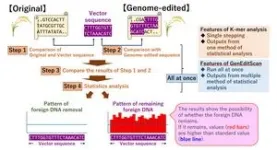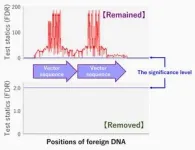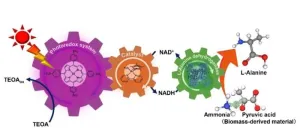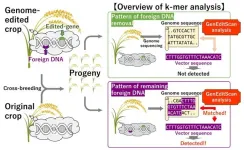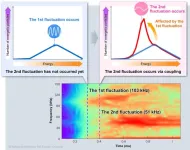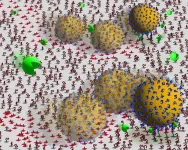(Press-News.org) When the going gets cold, even tough trees struggle with growing. Trees need a certain number of warm days in their growing seasons to grow properly; otherwise, the cell walls of new growth don’t lignify properly, creating ‘blue rings’ that appear when wood samples are dyed. Since trees and shrubs can live for hundreds of years, identifying these blue rings allows us to spot cold summers in the past. By looking at pine trees and juniper shrubs from northern Norway, scientists identified two extremely cold summers in 1902 and 1877, possibly caused by the eruptions of Mount Pelée on the island of Martinique and Cotopaxi in Ecuador.
“Blue rings look like unfinished growth rings, and are associated with cold conditions during the growing season,” said Dr Agata Buchwal of Adam Mickiewicz University, Poland, lead author of the article in Frontiers in Plant Science. “In general, we found more blue rings in trees than in shrubs. Shrubs seem to be more adapted to cooling events than trees, which is probably why shrubs are found further north. That is why I love to study shrubs; they seem to be the true heroes of the north.”
Growing pains
The scientists sampled cores from 25 Scots pine trees and stem-base discs from 54 common juniper shrubs at a site high on the treeline of Mount Iškoras in northern Norway. The team cross-sectioned and stained these samples, then photographed them under a microscope so that growth ring widths could be measured and cross-dated, and blue rings identified.
“Blue ring studies require a much longer protocol than classical dendrochronological studies,” Buchwal noted. “We are grateful to work with dedicated, highly-qualified lab technicians. Only together we can explore the blue ring world in high resolution using microscope slides!”
Overall, only 2.1% of the pine trees’ rings and 1.3% of the juniper shrubs’ rings were blue; the cells which hadn’t lignified properly were mainly found at the end of growth rings, in latewood. Blue rings occurred most frequently in 1902 — 96% of pine trees and 68% of juniper shrubs — followed by 1877 — 84% of pine trees and 36% of juniper shrubs. Pine trees seemed to be more vulnerable to blue ring formation than juniper shrubs, which could make them a more sensitive indicator of cold summers.
“In the case of pine trees in boreal regions, blue rings have the potential to weaken the tree, making it more susceptible to mechanical damage or disease,” explained Dr Pawel Matulewski of Adam Mickiewicz University, second author of the article. “If this phenomenon persists over several years, it can impede the tree's recovery in following years.”
Comparing this data with local weather records showed that 1902 and 1877 were characterized by very low summer temperatures. In 1902 the coldest June ever recorded delayed the growing season, so a low total number of days in that year were warm enough for tree growth. This could explain why earlywood formed almost normally in 1902, but latewood didn’t, creating many blue latewood cells: the growing season was too short, so the latewood didn’t have time to develop properly.
Comparing the cooling events — the 1902 event fell in June, when the growth season usually begins, and the 1877 event in August — suggests it may even be possible to differentiate between cooling at different times. Late cooling events may lead to more lignified cell walls and a ‘less blue’ ring.
Volcanoes’ long shadow
Other studies have linked blue rings to global climatic events, such as cooling after large volcanic eruptions. 1902’s cold June could be related to the eruption of Mount Pelée in May. Similarly, the late June eruption of Cotopaxi aligns with 1877’s cold August — but there is no other reported evidence for related cooling in northern Norway after this eruption. This blue ring could also be due to another, as-yet unidentified, factor.
Looking at other blue rings, the scientists identified more potential cold summer periods — but the weather seems to have been less cold, and some temperature data were missing, preventing analysis. The scientists also cautioned that temperatures among the trees might have been different to those recorded at the Mount Iškoras weather station: future research will need in-situ weather data.
“We hope to inspire other research groups to look for the blue rings in their material,” said Buchwal. “It would be great to establish a blue ring network based on trees and shrubs to reconstruct cooling events at the northern treeline over long timescales.”
END
Curious blue rings in trees and shrubs reveal cold summers of the past — potentially caused by volcanic eruptions
Blue growth rings found in woody plant stems represent years when cells did not lignify properly because of summers too cold for growth
2025-01-22
ELSE PRESS RELEASES FROM THIS DATE:
New frontiers in organic chemistry: Synthesis of a promising mushroom-derived compound
2025-01-22
Natural compounds from plants and animals have long been used in drug development, but mushrooms remain underexplored despite their rich chemical potential. Now, researchers from Japan have successfully developed the first method to synthesize inaoside A, a compound derived from the edible mushroom Laetiporus cremeiporus. This achievement will help better understand more of its bioactive properties and pave the way for similar mushroom-derived compounds in pharmaceuticals and functional foods.
Natural compounds derived from plants and animals have long been a source of inspiration when developing drugs and dietary supplements. Many well-established medical ...
Biodegradable nylon precursor produced through artificial photosynthesis
2025-01-22
Nylon, the durable and elastic material, is like other plastics made from chemicals found in fossil fuels. Biodegradable plastics based on biomass-derived compounds are attracting attention as an alternative to conventional plastics, and Osaka Metropolitan University scientists have now synthesized biodegradable nylon precursors.
Professor Yutaka Amao’s team at the Research Center for Artificial Photosynthesis previously reported on a method for producing raw materials for biodegradable plastics from biomass-derived compounds. ...
GenEditScan: novel k-mer analysis tool based on next-generation sequencing for foreign DNA detection in genome-edited products
2025-01-22
Genetic changes have the ability to alter crop characteristics, and some crop breeding techniques take advantage of this. Conventionally, genetic engineering has relied on natural or artificial mutations. In recent years, genome editing technology has been grabbing attention. Genome editing technology can target and cut specific DNA sequences, causing mutations in target genes. This makes it possible to develop new cultivars efficiently.
A common method for creating genome-edited crops involves introducing foreign DNA temporarily that produces an enzyme to cut the target ...
Survey: While most Americans use a device to monitor their heart, few share that data with their doctor
2025-01-22
RELEASE EMBARGOED UNTIL JAN. 22, 12:01 A.M. ET
Note to editor: photos and videos are available for download: https://bit.ly/4jkgIqT
Survey: While most Americans use a device to monitor their heart, few share that data with their doctor
Taking action with your doctor is critical for a proper diagnosis, action plan
COLUMBUS, Ohio – Advances in technology have made it increasingly easier for people to self-monitor their heart health whether it’s via a smart device on their wrist or finger or a blood pressure monitor. However, a new national survey commissioned by The Ohio State University Wexner Medical ...
Dolphins use a 'fat taste' system to get their mother’s milk
2025-01-22
Juvenile dolphins were found to have specialized receptors for fatty acids on their tongues, offering new insights into their growth and feeding habits.
Scientists have discovered that juvenile bottlenose dolphins have specialized receptors for detecting the fatty acids in their mother’s milk. These findings, published in the journal Marine Mammal Science, offer important insights into how these marine mammals grow, feed, and communicate.
The new findings challenge previous assumptions about cetacean sensory systems. Unlike land mammals, dolphins and other marine mammals have limited olfactory capabilities – their sense of smell is largely ...
Clarifying the mechanism of coupled plasma fluctuations using simulations
2025-01-22
Background
In nature, phenomena in which multiple fluctuations occur in a coupled manner are frequently observed. For example, in large earthquakes, cases of them occurring consecutively in adjacent regions have been reported. When multiple fluctuations occur in this coupled way, compared to a single fluctuation, the coupled ones release more energy, leading to larger-scale phenomena. In fusion plasmas, fluctuations caused by energetic particles exist and are known to degrade the confinement of energetic particles. ...
Here’s what’s causing the Great Salt Lake to shrink, according to PSU study
2025-01-22
The Great Salt Lake, the largest saltwater lake in the Western Hemisphere, reached historic low levels in 2022, raising economic, ecological and public health concerns for Utah. New research from Portland State is believed to be the first peer-reviewed study that quantifies the contributing factors to the record low water volume levels, which the researchers say is important for anticipating and managing future lake changes.
“The lake has a lot of social and economic relevance for the region and Utah,” said Siiri Bigalke, the lead author and a Ph.D. candidate in PSU’s Earth, ...
Can DNA-nanoparticle motors get up to speed with motor proteins?
2025-01-22
DNA-nanoparticle motors are exactly as they sound: tiny artificial motors that use the structures of DNA and RNA to propel motion by enzymatic RNA degradation. Essentially, chemical energy is converted into mechanical motion by biasing the Brownian motion. The DNA-nanoparticle motor uses the "burnt-bridge" Brownian ratchet mechanism. In this type of movement, the motor is being propelled by the degradation (or "burning") of the bonds (or "bridges") it crosses along the substrate, essentially biasing its motion forward.
These nano-sized motors are highly programmable and can be ...
Childhood poverty and/or parental mental illness may double teens’ risk of violence and police contact
2025-01-22
Living with persistent poverty and/or parental mental illness throughout childhood may double the risk of carrying and/or using a weapon and getting on the wrong side of the law by the age of 17, suggests research published online in the Journal of Epidemiology & Community Health.
These factors may account for nearly 1 in 3 cases of weapon use or carriage and more than a quarter of all police contact among 17 year olds, nationwide, estimate the researchers.
Youth crime and violence are common around the world, they note. In England and Wales, for example, around 104,400 first-time offenders were ...
Fizzy water might aid weight loss by boosting glucose uptake and metabolism
2025-01-22
Fizzy water might aid weight loss by boosting blood glucose uptake and metabolism—the rate at which the body uses and converts energy—but the effects are so small, drinking it can’t be relied on alone to shed the pounds, concludes a brief analysis published in the open access journal BMJ Nutrition Prevention & Health.
There are no quick fixes to slimming down and keeping off the weight, says the author: regular physical activity and a healthy balanced diet are still essential, added to which the long term effects of drinking large amounts of carbonated water aren’t known.
Because ...
LAST 30 PRESS RELEASES:
Making lighter work of calculating fluid and heat flow
Normalizing blood sugar can halve heart attack risk
Lowering blood sugar cuts heart attack risk in people with prediabetes
Study links genetic variants to risk of blinding eye disease in premature infants
Non-opioid ‘pain sponge’ therapy halts cartilage degeneration and relieves chronic pain
AI can pick up cultural values by mimicking how kids learn
China’s ecological redlines offer fast track to 30 x 30 global conservation goal
Invisible indoor threats: emerging household contaminants and their growing risks to human health
Adding antibody treatment to chemo boosts outcomes for children with rare cancer
Germline pathogenic variants among women without a history of breast cancer
Tanning beds triple melanoma risk, potentially causing broad DNA damage
Unique bond identified as key to viral infection speed
Indoor tanning makes youthful skin much older on a genetic level
Mouse model sheds new light on the causes and potential solutions to human GI problems linked to muscular dystrophy
The Journal of Nuclear Medicine ahead-of-print tip sheet: December 12, 2025
Smarter tools for peering into the microscopic world
Applications open for funding to conduct research in the Kinsey Institute archives
Global measure underestimates the severity of food insecurity
Child survivors of critical illness are missing out on timely follow up care
Risk-based vs annual breast cancer screening / the WISDOM randomized clinical trial
University of Toronto launches Electric Vehicle Innovation Ontario to accelerate advanced EV technologies and build Canada’s innovation advantage
Early relapse predicts poor outcomes in aggressive blood cancer
American College of Lifestyle Medicine applauds two CMS models aligned with lifestyle medicine practice and reimbursement
Clinical trial finds cannabis use not a barrier to quitting nicotine vaping
Supplemental nutrition assistance program policies and food insecurity
Switching immune cells to “night mode” could limit damage after a heart attack, study suggests
URI-based Global RIghts Project report spotlights continued troubling trends in worldwide inhumane treatment
Neutrophils are less aggressive at night, explaining why nighttime heart attacks cause less damage than daytime events
Menopausal hormone therapy may not pose breast cancer risk for women with BRCA mutations
Mobile health tool may improve quality of life for adolescent and young adult breast cancer survivors
[Press-News.org] Curious blue rings in trees and shrubs reveal cold summers of the past — potentially caused by volcanic eruptionsBlue growth rings found in woody plant stems represent years when cells did not lignify properly because of summers too cold for growth

